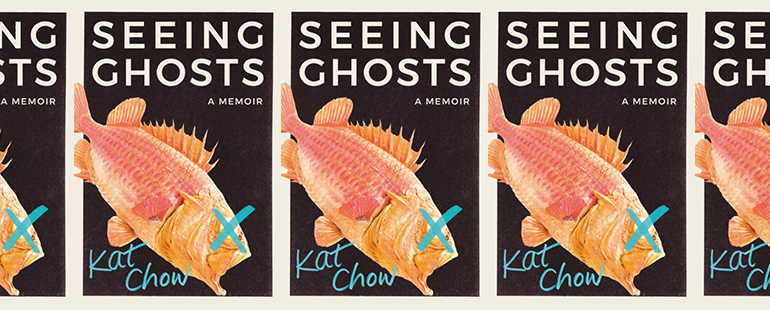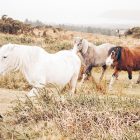“I’ve always been drawn to writing about the body—our physical selves and how they reflect our inner lives”: An Interview with Kat Chow

Despite the title of Kat Chow’s debut memoir Seeing Ghosts, out today, the book is very much about bodies. In it, Chow, a founding member of NPR’s Code Switch team, both mourns the early death of her mother, who died from cancer in her mid-forties just as Chow was beginning high school, and examines the legacy of the diseases that have befallen the bodies of her family members over the generations, and the way in which the circumstances of these illnesses mirror each other. Chow’s mother grew up without a mother of her own—Chow’s grandmother succumbed to uterine cancer when Chow’s mother was four. Since Chow’s grandmother was cautioned by doctors to abort her pregnancy with Chow’s mother because of the cancer already growing in her womb, Chow suspects that her mother may have felt some guilt for her mother’s death, though she never admitted as much. “Did you hear growing up that, had you not been born, your mother’s cancer might not have been as deadly?” Chow imagines asking her mother. Chow often considers what could have been—not just in her life but in the generations before (periodically, Chow incorporates Cantonese into her recollections, though it is the language of the generation above her, not a language she can speak fluently, and its place in the book communicates experiences beyond herself at the center of them)—particularly as what could have been relates to bodies and the ways in which they betray in life, as well as where they rest in death. By doing so, Chow unites generations that are often separated by country, language, education, and other factors.
The possibility of her mother being aborted is one way Chow considers what could have been; it also suggests that her own existence is conditional, that she easily could not have been born at all had the universe gone in a different direction. Her existence, she notes, is also predicated on the death of her older brother, Jonathan, who died hours after birth from tracheal agenesis, “a rare condition where the windpipe fails to develop.” “I was afraid to confront the possibility that had my brother not died, I wouldn’t have been born—and that just talking to my mother about her son would trigger her regret and render me a mistake,” Chow writes. “How strange it is to think about my existence as a debt to my dead baby brother.” Death and birth are conjoined again here, one person’s death yielding to another’s life, the dead haunting the living.
Chow’s mother’s ghost plays a particularly important role in her life, and she interacts with her in her daily life: Chow addresses an imagined version of her mother’s taxidermized body throughout the book. Having once joked about being taxidermized upon her death, before she even knew she had cancer, this joke manifests into the ghost that Chow conjures and clings to after her mother has passed. By imagining her mother’s bodily form, Chow doesn’t lose her mother entirely, even though her body betrayed her.
The conversations Chow has with her mother’s ghost ground Chow’s consideration of the legacy of cancer in her family and the terrifying vulnerability of bodies, and how that vulnerability can be passed through generations. Two years before Chow’s mother’s death, doctors removed a nine-pound cyst from her abdomen. After her cancer diagnosis, her body expired within weeks. Chow asks her mother, “I wonder now if you ever felt betrayed by [your body], if you raged that the form that was meant to protect you instead failed before you were ready to expire.” There is a pattern here: first, the untimely failure of Chow’s grandmother’s body from uterine cancer, and then the ways in which her mother’s body fails. Chow herself puts off visiting a gynecologist, fearing the discovery that her body may have betrayed her. Her oldest sister, Steph, struggles to get pregnant, the possibility of a body’s inherited failure lurking again. Steph has two surgeries to remove fibroids, one surgery removing 18, the next 37. Eventually, Steph becomes pregnant and gives birth to a son, a triumph the whole family feels. Chow blends these present body betrayals and possible betrayals with her mother’s bodily presence as a taxidermized body rather than a more ethereal ghost, underscoring the power of bodies even in death.
As Chow navigates her mother’s physical absence, she does begin to question her impulse to bodily insert her into scenes, real or imagined. “Perhaps instead of asking if I am exorcising or taxidermizing you, I should ask if really, I am taxidermizing myself,” she wonders. “What within my grief am I afraid to lose? It is the idea of her, of course.” The grief Chow plunged into at age 14 is the grief she continues to muddle through a decade later. Once, grief strikes on a family trip to China when Chow is an adult, and she begins sobbing in the shower until her sisters urge her out so they can comfort her. Another time, she wakes from a nightmare and wanders the hall of her dorm until a fellow resident pulls her into a hug, telling her it will be okay, an interaction she didn’t know she needed and that prompts her to realize just how much she was still grieving. Getting the help she needed as a teenager was challenging for Chow since her father dismissed therapy as “stuff in the head”—and therefore stopped paying for the grief counselor the school arranged for Chow to see (though they generously continued to see her). He failed to realize the accuracy of his statement and how much his daughters needed this support. Grief, then, becomes its own sort of taxidermizing tool—Chow still clings to her mother. “It perplexed me then how grief could still be there like that, injected into my body as if some preserving agent, indistinguishable from my insides,” Chow writes, imagining her mother into bodily form rather than letting her rest.
As much as Seeing Ghosts is about her mother, the memoir comes to be about Chow’s father, too. Though her older sisters are supportive and nurturing, they’re already out of the house when their mother dies, so their father is the only one home with Chow. He is miserly and bad with money, and his disposition masks his love for his girls. “I often wondered—and still sometimes do—what our lives would have been like had my mother lived and he died,” Chow writes. “Would she have re-married? Would I have had the childhood I did, or the life I have now? I hate her death for how it knocked my family down, but I hate also how I believe I needed it to become who I am.” Chow sees again a way that life and death are inherently and painfully conjoined. Without her mother’s death, her life would be so different—maybe better—but her father’s survival and her mother’s death inherently shapes her life. Ultimately, Chow begins to address her father. “Daddy, all of this time, perhaps I have been trying to preserve the memory of you, too,” she writes. “To hold you in my mind; to try to see all the ways light reflects off your image.” Loving and living with her father is complicated. Chow’s maternal relatives blame her father for his wife’s death, for not seeking essential medical care for her sooner; they blame him for not caring for his family financially. Chow learns, and her father confirms, that her mother had talked about leaving him after their daughters were out of the house. And yet this is the parent Chow is left with, and her love for her father is apparent throughout her reckoning. She and her sisters want him to be okay, to be happy, too, and they see the ways he has provided for them even if they are less straightforward than the ways their mother did.
While so much of Seeing Ghosts is focused on the generational experiences on her mother’s side, Chow examines the generational circumstances on her father’s side, too, which is one way Chow demonstrates how much her father means to the sisters. They take a trip to Cuba where her paternal grandfather was buried, though the exact location of his remains was unknown to them and possibly lost. Again, the significance of bodies—living or dead—returns. “I know, after all, that where a body rests says so much,” Chow writes. The body’s physical location never stops being important, especially those bodies that should be at rest together. For her father, this means reuniting his parents’ remains, since his mother’s bones were interred in Canada; eventually, he’s able to locate his father’s remains and fulfill this wish. As her dying wish, Chow’s mother asked that Jonathon’s ashes be buried with her, a request that the family doesn’t fill until over a decade later. When they do, her mother’s ghost is finally able to rest, and Chow’s taxidermized mother disappears.
Sarah Appleton Pine: Your memoir has a very generational feel, especially given the fear that you face as a daughter (alongside your sisters) of inheriting the diseases that felled your mother and grandmother—this fear that your body will betray you too soon, just as their bodies betrayed them. In general, bodies feel so important here—the live, healthy body versus the diseased body versus the preserved body versus the cremated or buried body. Bodies, of course, contrast sharply with ghosts, which may subvert your reader’s expectations. How would you describe the significance of bodies in your memoir or more broadly in your family culture?
Kat Chow: I’ve always been drawn to writing about the body—our physical selves and how they reflect our inner lives—and how our bodies are an inheritance from our parents and the generations that come before. I wanted Seeing Ghosts to reflect how for many years, I felt out of my body when I tried to face my family’s grief. I tried to create a visceral quality when describing my mother, with the faces she liked to make, her stomach scars, her cancer, her skin—and my father, too, with his teeth, his hair, his hearing. The taxidermic ghosts or visions usually had some strange, otherworldly quality, but were still very grounded—stiff limbs as a call back to the monsters my mother invented when my sisters and I were children, for example—and had playful or human reactions to whatever scenario they were in. It was also important for me to shift around with active voice and passive voice when writing about these physical details: things happening to our bodies, often without our control. I wanted to reflect the ways we can sometimes feel maneuvered through exhausting systems that make up our society and force us to fight for our survival.
SAP: I’m fascinated by the role taxidermy plays in your memoir. By invoking your taxidermized mother, she feels so present in a way that memory or even a ghost doesn’t allow for. And your taxidermized mother sharply contrasts with your father’s botched DIY taxidermy of a sea bass, which certainly seems horrifying! How did the role of taxidermy expand from the joking comment your mother once made?
KC: Taxidermy in real life scares me very, very much! Ever since I was a kid, my skin crawls and I feel a little panicky whenever I see an animal that’s been taxidermied. My flight instinct kicks in, and to this day, I still struggle with certain exhibits in natural history museums.
I wanted to play with this fear. I thought taxidermy was such a fascinating metaphor both for experiencing loss and grief, and also for writing this story. There’s this joke my mother made that opens the book, about her wanting to be stuffed and kept in my future apartment so that she could always watch over me. That was such an absurd thing to tell a kid, especially a kid who was so afraid of dead things. But I thought about this image often after she passed, and I knew it would make for an interesting device to bring this narrative together.
Taxidermy more generally makes me think of the way my relatives grieved, which was to put so much emphasis on ancestor worship and the belief that we needed to appease the dead, otherwise their spirits would become restless. That’s a haunting concept to grow up with, but as an adult, I find it comforting. I knew very early on in this process that it could merge with my mother’s joke into something strange and macabre and at times add levity.
I was drawn to how my father’s botched taxidermy made me think so much about the intention behind it—wanting to preserve something that had died and was in the process of decaying, and trying to alter it so that it resembled its living self. DIY taxidermy is such a difficult thing to do, and fish are also some of the hardest animals to work on, so of course it was nearly impossible for my father to give it this intangible quality—life. His general draw toward taxidermy also called to mind his need to hold onto objects around his house, and how he imbued each of those things—saws, car batteries, takeout containers, orange peels, peanut shells—with so much meaning. I found his botched taxidermy to be similar to a melancholic grief, and I wanted to capture that.
And in a way, I also found that writing about my mother was similar at times to taxidermy. This assembling of her whole self through this collection of memories, of using my words to try to create an image of her.
SAP: Language feels important here in expressing your grief, your connection to your family, and your family’s connection to each other, as well as your own recollection of your memories. What choices did you make around language in the memoir?
KC: I wanted to use Cantonese to reflect the longing I had for my mother and my inability to speak the dialect fluently, but also this need to understand the words she used to describe her illness or, for example, the origins of her name. I knew as a baseline that I didn’t want to translate any of the Cantonese in this book, and that non-Cantonese speakers would be able to follow along with context clues. I thought, also, this might evoke the feeling I get sometimes when I’m listening to someone speaking quickly in Cantonese, where I generally understand what they’re saying, though I might not be able to translate perfectly.
Though I’ve been taking Cantonese lessons on and off for the past few years, I worked with the translator and editor Jaime Chu on making sure the romanization of the Cantonese was OK and consistent throughout. My publisher’s production editor hired a copy editor named Helen Chin who spoke Cantonese—this gave me another layer of comfort and security.
On another note, regarding language: I tried to stay away from anything that felt overwrought or sentimental. I wanted to be ruthless about trimming any unnecessary explication, so that emotions could stand on their own through the scenes. I love Diana Khoi Nguyen’s poetry for its ability to do this, as well as memoirs like Men We Reaped by Jesmyn Ward, Long Live the Tribe of Fatherless Girls by T Kira Madden, Heart Berries by Terese Marie Mailhot, and The Light of the World by Elizabeth Alexander, and fiction by Yiyun Li, Gish Jen, and Sigrid Nunez.
SAP: Although Seeing Ghosts seems mostly to be about your mother, your father plays a crucial role, too. At one point you even shift your address so that “you” refers to him and not to your mother. Was this focus and shift intentional? Did it catch you by surprise?
KC: I understood when I was in the middle of my first draft that this book really was so much about my father as well. This caught me by surprise, and I think for a long time, I was trying to avoid writing about him. But I realized I had to address him as “you,” because I wanted to show how he is perhaps as inaccessible as my mother, how ghost-like we still can be in our understanding of one another.
SAP: You end the memoir with a scene of you and your family finally burying your brother’s ashes with your mother as she requested, and you imply that your mother (or her ghost) no longer haunts you now that you’ve fulfilled this request. “Memory is capital. It is love and survival. And hope. It is all we have,” you write. “You wink again. To return the gesture, I shut my eyes, slow and long. When I open them, you are gone.” Does this fulfillment of her wish rest her spirit and un-taxidermy her? Or having fulfilled her wish, are you choosing to no longer summon her?
KC: I’ll let each reader decide on that. 🙂
This piece was originally published on August 24, 2021.



